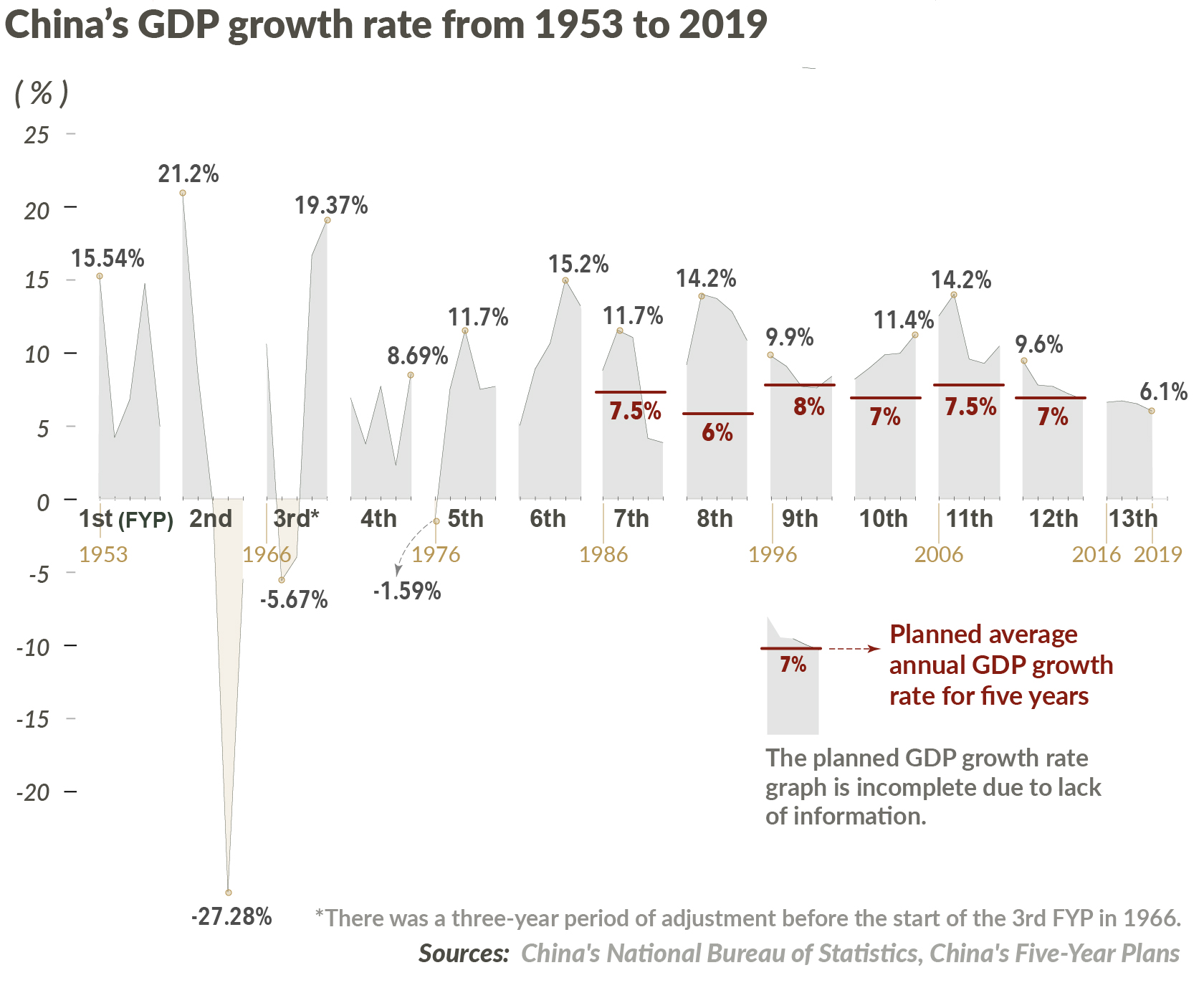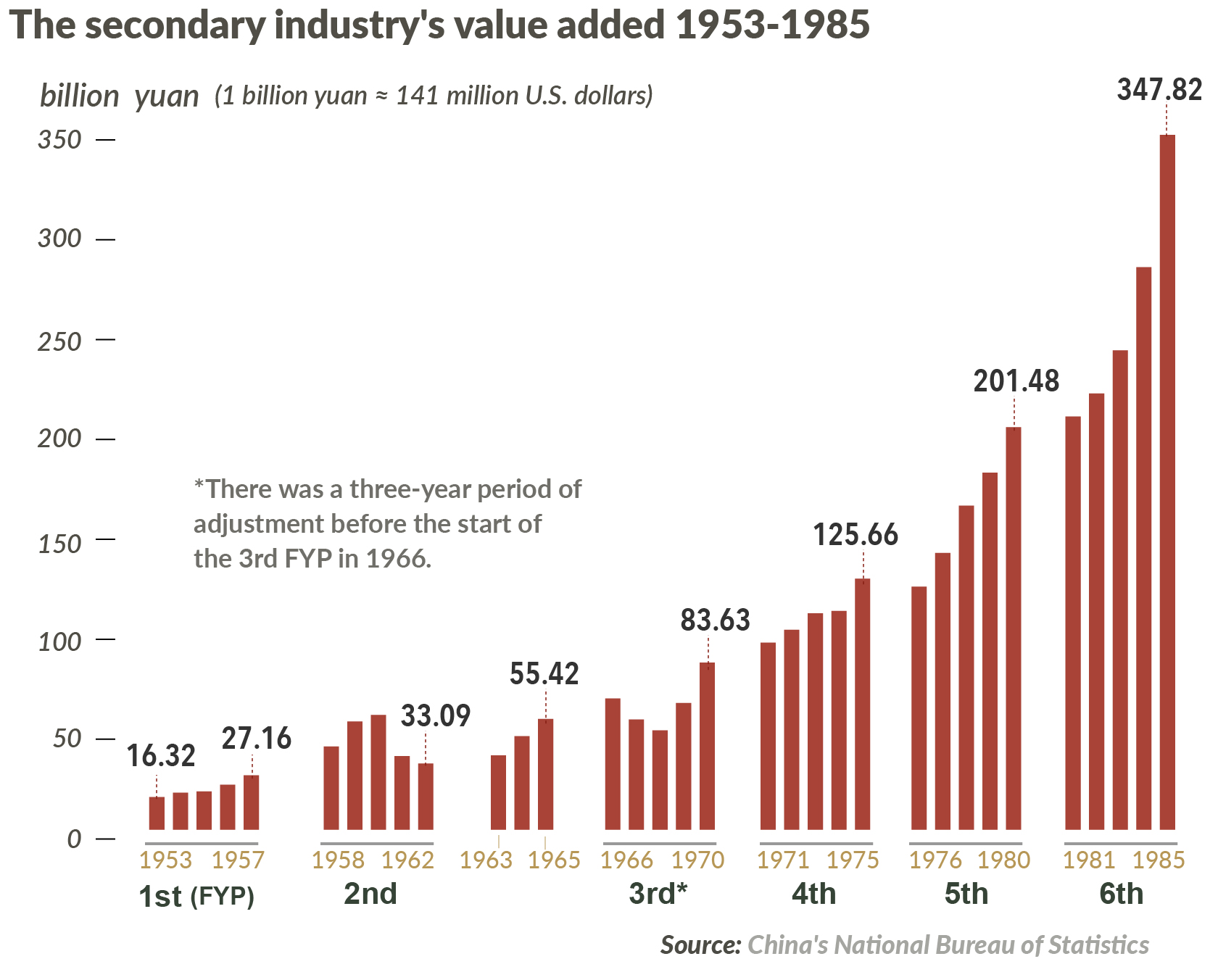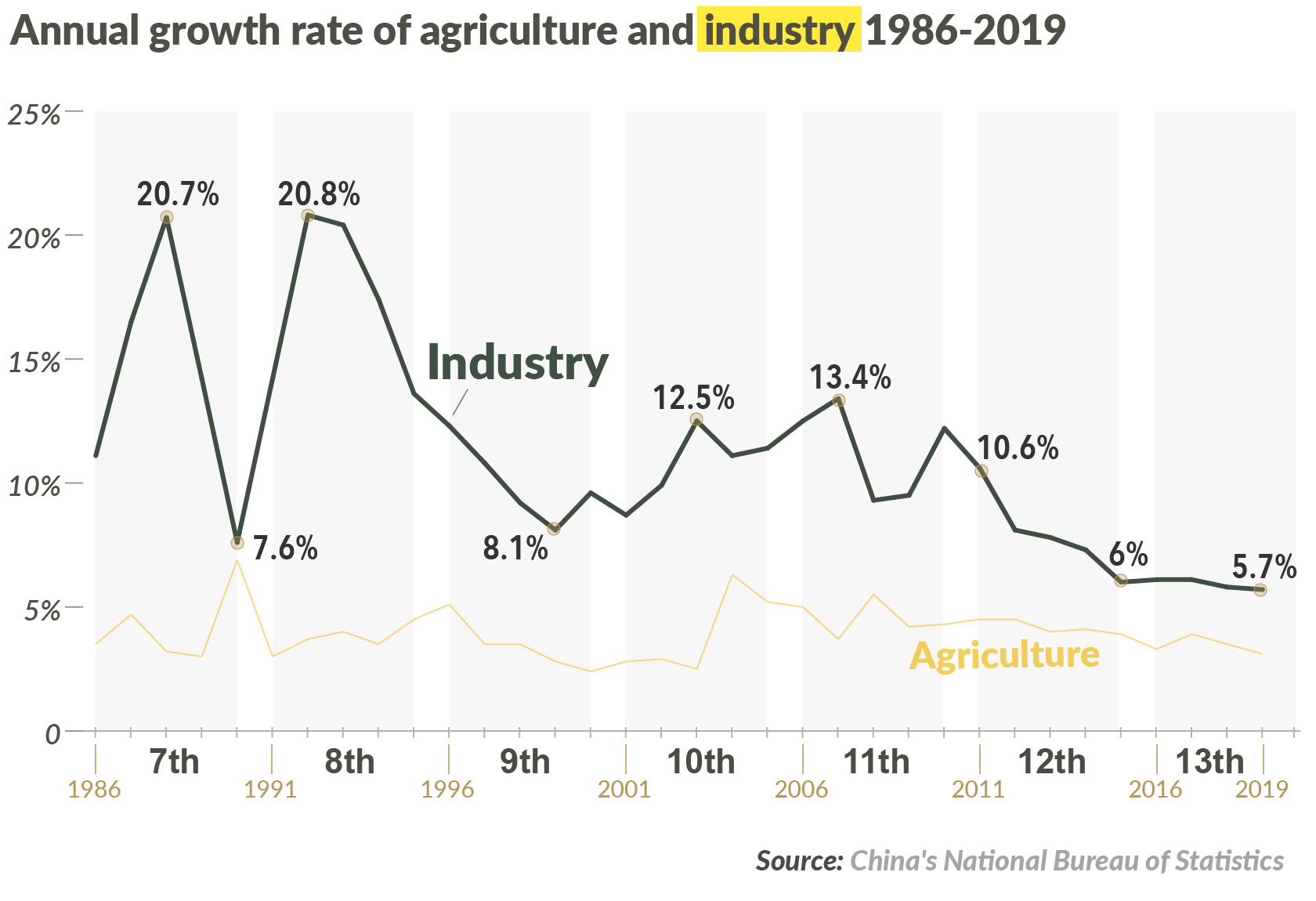



1953
I
1957
1986
VII
1990
1991
VIII
1995
1996
IX
2000
2001
X
2005
2006
XI
2010
2011
XII
2015
2016
XIII
2020
China's Five-Year Plan (FYP) is one of the country's most importantpolicy blueprints. Drawn up since 1953, it sets medium-term goals for China's social and economic development and is the barometer against which progress is measured.
2020 is the last year of the 13th Five-Year Plan, which was adopted on March 15, 2016. The 14th plan (2021–2025) is currently being developed.
This table shows the outlines of each of China's FYPs*. The length of the 1st FYP (1953-1957), which served as the foundation for future plans, is longer than the rest. Its total word count is 80,295.
By comparison, the number of policies drops for several years after 1953 but starts to climb consistently in 2006.
*The second to sixth FYPs are not listed, as they are not available.
Here we delineate the primary objectives of the FYPs from 1953 to date.
China's Five-Year Plan lays out specific economic targets, such as GDP growth rates and social development goals in healthcare, environment and other areas.
The primary objectives include economic reform and industrial restructuring, which have paved the path for establishing and improving the socialist market economy and formed the foundation for transforming the mode of economic growth and optimizing economic structure.
Starting from the 7th FYP (1986-1990), every FYP projected an average annual GDP growth rate, making it an essential indicator for measuring the national economy for the next five years.
However, China announced on May 22 that there would be no specific target set for its economic growth in 2020 because it is facing some unpredictable factors in its development as well as high uncertainty regarding the COVID-19 pandemic and the global economic and trade environment.

In terms of contribution to the GDP, the secondary sector maintained a bigger share with a dwindling primary sector and a growing tertiary sector.

The industrial sector has been the primary driver of China's economic development and the driving force to shift China's economic structure into a high-quality growth pattern.
Here we highlight all the texts related to the industrial sector.
The related content accounts for nearly half of the 1st FYP.
As China diversifies its approach to national development, the number of policies directly related to the industrial sector has fallen.
Here are the titles of the chapters or sections on industry.
During the 1st FYP, China focused on developing its heavy industry.
The annual value added of the industrial sector declined at the end of the 2nd FYP (1958–1962) but rallied during the three-year period of adjustment that followed. It dipped to 49.7 billion yuan in the 3rd FYP (1966–1970) but has remained above 80 billion yuan since the 1970s.

China's industry growth rate was in a downward trend when the government unveiled "Made in China 2025," a 10-year national strategy put in the 13th FYP (2016–2020) to upgrade the country's manufacturing sector.

China is the world's largest agricultural producer, producing a fourth of the world's grains.
Content related to agriculture is highlighted. Most FYPs make fewer references to agriculture than industry.
Here are the titles of the chapters or sections on agriculture.
Agriculture remains a vital sector in the national economy, though its growth rate has typically been lower than that of industry.

Plans for rural development appear in the second part of the 11th FYP (2006–2010), called "Construction of New Socialist Villages." In the subsequent FYPs, rural development plans make up a whole chapter listed at the top of the document.

explore other sections....
 Click on section to explore
Click on section to explore"We take the capital construction of heavy industry as the focus of the 1st FYP for the development of the national economy and start with the 156 industrial projects the Soviet Union designed to help China."
"We will fully implement the 'Made in China 2025' action plan… to foster a new competitive edge in manufacturing."
"We will continue to give top priority to resolving the issues concerning agriculture, rural areas and farmers,…promote the construction of a new socialist countryside, and promote the sound development of urbanization."
"We take the capital construction of heavy industry as the focus of the 1st FYP for the development of the national economy and start with the 156 industrial projects the Soviet Union designed to help China."
"We will fully implement the 'Made in China 2025' action plan… to foster a new competitive edge in manufacturing."
"We will continue to give top priority to resolving the issues concerning agriculture, rural areas and farmers,…promote the construction of a new socialist countryside, and promote the sound development of urbanization."
AFTER the SARS outbreak, China issued a set of Regulations on Public Health Emergencies in May 2003 amid the 10th FYP (2001–2005) period. In its 11th FYP (2006–2010) in 2006, China made plans to establish a public health emergency response system.
IN the 13th FYP (2016–2020), China expanded the public health section into an entire chapter, mapping out plans to "promote a healthy China." Earlier FYPs mainly focused on building medical facilities and expanding medical staffing before shifting to rural health. The more recent FYPs focus on system building and reforms.
THE phrase "a country based on the rule of law" was first mentioned in the 10th FYP (2001-2005) and replaced "a country with a legal system" in the 13th FYP (2016–2020), reflecting China's desire to achieve the overarching goal of modernizing the country's system and capacity for governance based on the rule of law.
CHINA'S two key political systems, the National People's Congress and the Chinese People's Political Consultative Conference, whose purpose is to give full expression to the will of the people, protect their rights and interests, spark their creativity, and provide systemic and institutional guarantees to ensure the people run the country, have been mentioned from the eighth to 13th FYPs.
"All scientific research institutions should strengthen their research on practical issues related to nation building."
OVER the years, China's application of science and technology has changed from a solutions-based approach, offering immediate solutions to practical issues in the 1st FYP (1953–1957), to becoming a driver for economic development in the 13th FYP (2016–2020).
"China will increase its proportion of research and development expenditure to more than 1.5 percent of the GDP."
THE money being put into sci-tech development has been increasing since the 10th FYP (2001-2005). According to World Bank data, China's ranking in research and development expenditure has risen from 30th in 1996 to 13th in 2017.
"With scientific and technological innovation as the core and talent development as the support, we will integrate scientific and technological innovation with entrepreneurship and innovation to foster more innovation-driven, cutting-edge development."
"Carbon dioxide emissions per unit of GDP will decrease by 17 percent... China must significantly reduce its energy consumption and CO2 emissions, as well as effectively regulate greenhouse gas (GHG) emissions."
IN 2016, China joined the Paris Agreement. According to the 2019 report on China's Policies and Actions for Addressing Climate Change, China's CO2 emissions per unit of GDP dropped by 45.8 percent from the 2005 level, meeting the target of a 40 to 45 percent decrease by 2020 ahead of schedule.
"We will strengthen the economic cooperation of the socialist bloc led by the Soviet Union, expand our trade with the Soviet Union and steadily increase our trade with the people's democratic countries.....We will consolidate state control of foreign trade to prevent capitalist attacks while protecting China's socialist structure."
FROM the first to the fifth FYPs, which precede China's reform and opening-up, the country had protectionist policies. Its major trading partners were the Soviet Union and the socialist countries in Eastern Europe.
"China will continue to reform the foreign trade management system and further promote foreign trade…. China will also further expand the operation rights of local governments and departments and relax restrictions on export-oriented enterprises to encourage them to develop foreign trade."
IN 1986, China published its 7th FYP (1986–1990), clearly stating that the country will put more effort into its foreign trade policy reform and remove limitations on enterprises. China's imports and exports increased significantly over the next five years.
"To meet its commitment to joining the WTO, China will gradually lower tariffs according to the country's socioeconomic status and industrial structure. China will also gradually open up services such as banking, insurance, telecommunications, foreign trade, domestic trade and tourism."
CHINA formally joined the World Trade Organization at the beginning of the 10th FYP (2001-2005) and further adjusted its trade policy. During this period, foreign trade experienced a sharp increase.
"The growth of national defense and administrative costs must be properly controlled."
SINCE the 6th FYP (1981-1985), China's defense expenditure has grown in tandem with the growth of the national economy and government expenditure. However, its proportion of GDP shows a clear downward trend from 5.43 percent in 1979 to 1.26 percent in 2017. China's defense expenditure has remained within two percent of the GDP in the past 30 years.
"We will adhere to the principles of state leadership, system innovation, market operation and civil-military compatibility, coordinate economic national defense construction, fully rely on and utilize social resources, improve national defense strength and military capabilities, and vigorously promote the open sharing of military and land resources as well as the mutual transfer of military and civilian technologies."
ACCORDING to the 2019 white paper "China's National Defense in the New Era," China's national defense expenditure is mainly composed of personnel expenses, training maintenance and equipment expenses. In 2017, China's total defense expenditure was 1,043 billion yuan (146.9 billion U.S. dollars), accounting for 5.14 percent of the government expenditure, of which personnel expenses accounted for 30.8 percent, training maintenance 28.1 percent, and equipment 41.1 percent.
ECONOMIC development remains the center of each FYP. Content on economic development and industrial restructuring is put on the top list of the targets and tasks for each FYP.
See more about objectives
See more about industry
See more about agriculture
See more about health
See more about governance
See more about sci & tech
See more about environment
See more about trade
See more about defense

China's Five-Year Plans (The second to sixth FYPs are excluded, as they are not available.)
*Please note: The analysis in this project is based on the Chinese version of the Five-Year Plans.
Editors: Zhao Hong, Le Tian
Copy Editor: Claudine Housen
Chief Editor: Chen Ran
Data Editors: Zhou Rui, Shi Tao
Visual & Interactive Designers: Qin Zhaoying, Li Yixiao
Interactive Developers: Qin Zhaoying, Duan Huiran(Intern)
Testing Engineers: Zhang Sheng, Zhang Yupeng, Zhang Dongbo
Technology Support: Li Jian
Multimedia Producer: Xu Jiye
Senior Consultant: Dr. Xia Jixuan
Managing Director: Zhang Shilei
Supervisor: Fan Yun

Copyright © 2020 CGTN. Beijing ICP prepared NO. 16065310-3
